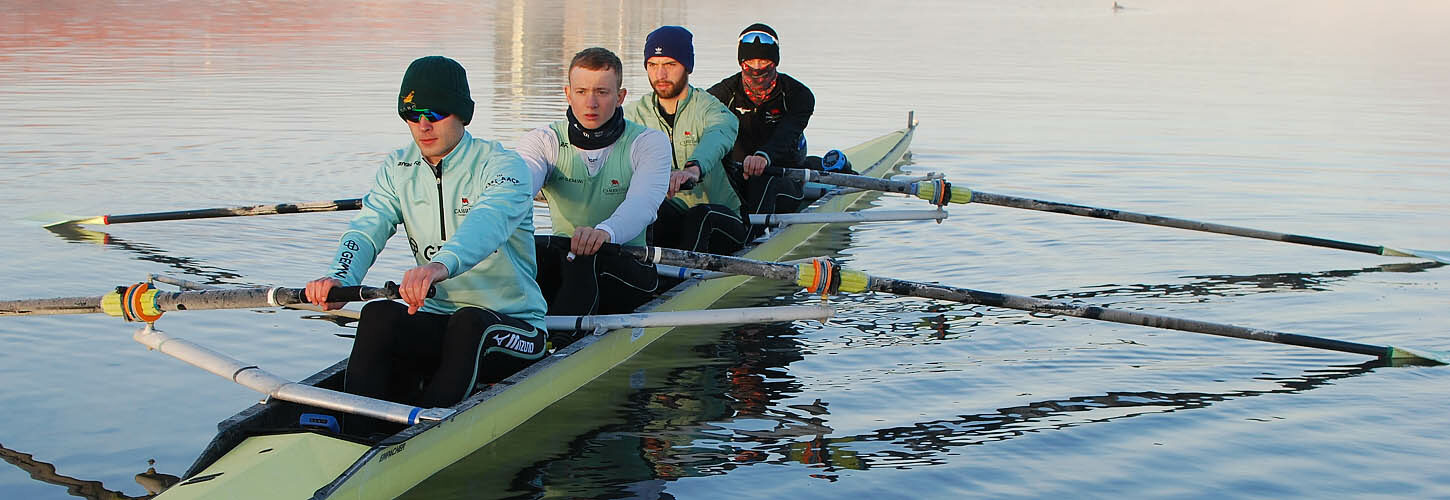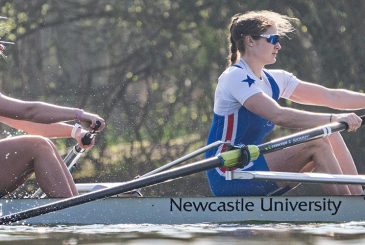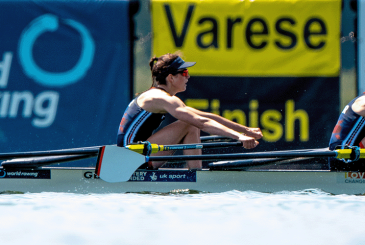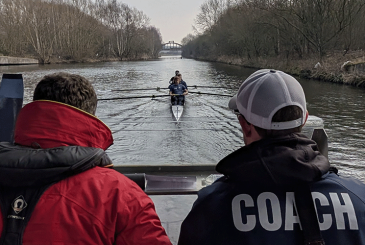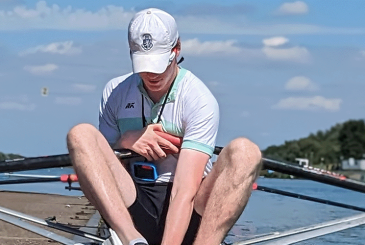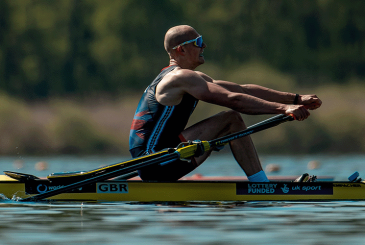Coach consultant Robin Williams looks at mass and momentum in the stroke cycle in his second article exploring the recovery to help you gain more ‘free’ speed
In the first article here, I began to look at why the recovery potentially carries big rewards for speed, if you have the skills. I mentioned the issues of the mechanical movements versus feel, the peak velocity of the hull at low speed compared to high, seven problem areas, and some exercises to improve our skills. The challenge is one of movement, largely. Can you recover in a way which complements the speed you have created during the drive?
Here, I want to explore this some more and look at mass and momentum in the stroke, how to position your weight for sweep rowers, hand heights, and some more training drills so you can continue to upskill yourself and get more ‘free’ speed.
Reference points
Firstly, it helps a great deal in crew boats if people can identify reference points, that is, points in the stroke cycle when they know they are in the right place at the right time, with each other, in the right position, and with control. The finish is one of these, a quarter slide is another (early preparation stage), and three-quarters slide is another (late preparation stage). If the crew can tick all three reference points, there is a decent chance of beginning the next stroke well. The finish itself has many advantages as a reference point. It is worth mentioning some of them again and explains why single strokes to the finish is a popular drill for bringing the timing together.
The finish
- Balance: The legs are flat, and the centre of gravity is low in the boat compared to the catch, so it’s a more stable position. Balance is going to be important when we move off the finish.
- Relaxation: you can sit at the finish as long as you like. The work in the muscles has finished and you can watch the puddles disappear sternward. The catch is not the place to hesitate, so people tend to be more relaxed at the finish than at the catch.
- Posture: Compared to the compressed, bunched-up position at the catch, the finish is open and much easier to sit back, tall, and well-set in the hips.
- Visibility: the rower can see the blade, knees, and feet. At the catch it is behind you and out of view, knees compressed in your chest, feet below you, so there’s much more of a reliance on feel compared to the finish.
- Stillness: it is the ONLY part of the cycle where the three masses of boat, body and blades are all behaving as one, travelling in the same direction for a moment. As soon as the hands move away, or body or slide takes place, the rower’s mass and oars are moving counter to the hull. In the drive, the rower also moves down the boat from front stops to back stops.
- Time: because of the above, there is this vital moment of time, and time allows relaxation, which allows skill and control.
If you are in control of yourself, you are in control of time.
Quarter slide
This is a really important reference because by this point, or certainly by one-third slide, you really need to have set your upper body for the next stroke. Remember the mantra that ‘the first part of the recovery is for you, the second part is for the boat’? Another way of phrasing it is to say you need to recover your mass first, and then the boat. More on this later.
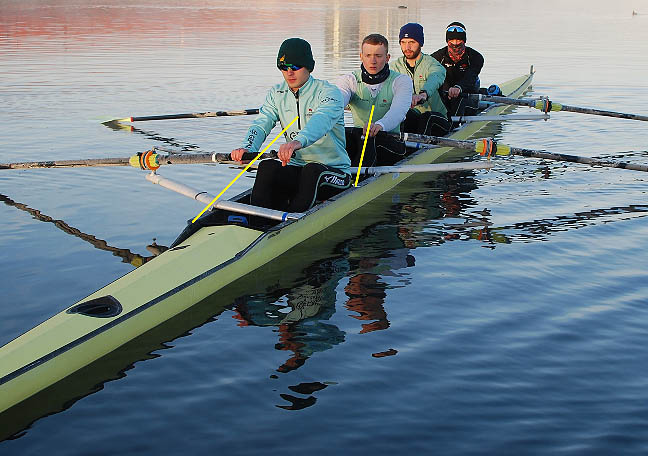
Moving from the finish to quarter-slide includes one critical aspect – how to shift your weight. For me, the idea is that the handle ‘leads’ your arms out from the finish, and if your handle keeps going past your knees, it will in turn draw the shoulders forward (and down in their sockets, not hunched), and then bring the rock over in the trunk. A common problem is that people don’t reach far enough along the boat, so the handle barely gets to the knees. This usually means they don’t achieve a proper shift of weight forwards on the seat, the hands rise too early, and it can lead to dipping at the front.
Shifting weight
For scullers this is quite simple. Following the point above, extending the handles out beyond the knees and along the mid-line of the boat, should do it. For sweepers, it’s more complicated, but shifting weight correctly can make balance much easier later on. The trick is to tilt forwards diagonally, so that your nose, chin, and sternum line up with your inside knee. You can try this out on land, and then in the boat.
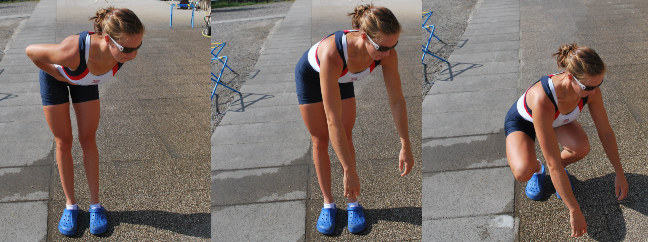
If stroke-side and bow-side both do this early on, by the time the hands are past the knees and knees unlocked (ie a quarter slide), then the balance has been set before any significant sliding has happened.
Tip: as you rock over forwards think about pushing the wheels of the seat back a half turn.
So, although there may be up to EIGHT crew moving, there is only ONE boat, and if the crew allow the boat to come to them from a quarter slide to full, there is ONE slide speed too. The hull will draw you to the catch position together and the timing point is created by the hull, not the crew. This makes a huge different to the entry and connection because you maintain control of your movements, hands, trunk, and slide. The thinking is that ‘from a quarter slide I sit still, relax, and let the boat come to me’.
Balance and hand heights
Shifting weight correctly is the main influence on balance side to side, but also front to back. The hand heights are the other important factor, but if you sit badly then no amount of hands up/down will help. Good hand movements off the finish and away is something every rower needs to practise because it sets up the recovery process. Faults usually go in pairs – poor hands away is often the result of a collapsed finish (feathering the blade out poorly) or over-pulling. Equally, a good movement sets up the next correct one, so good hands away and shift of weight, with the handle following the slope of the thighs, puts you nicely balanced between seat and feet in the mid-recovery.
Useful drills
- Finish dips, leading to arms roll-outs, then roll out to quarter-slide, on the balance.
- Finish dips – do them one hand at a time to feel the weight difference in each hand, with square blades, and finally, with higher movement speeds to simulate a racing recovery.
Once you are expert with the feel of the handle in each hand and your own weight from finish to rock-over, then getting to the quarter-slide reference position is easy.
- Quarter-slide rowing. This is a compound drill which you can do in three stages:
- First, low rate, low pressure
- Second, low rate, high pressure
- Third, high rate high pressure.
Stage three can be done for several minutes and at race rate. It is not physically tiring, but it does allow you to entrench the movements and weight shifts at racing cadence.
Three-quarter slide and control of mass
This concept of the ‘boat comes to you’ arises because the mass of the rower or crew is roughly five to seven times that of the hull, so the propensity to damage your own hull speed at the front end is high.
If you are ‘going to the boat’, i.e. sliding faster than the hull, then logically your mass needs to come back under control if you are going to change direction at the front. Think of continuous squat jumps where you descend too fast: your drop weight makes you heavier against the floor and harder to make the next jump. Any weight against the boat (stern) will slow it down and make the next stroke heavier. This is where you can get ‘free’ speed in rowing because if you handle your own mass well, and can time the pick-up through the feet by being nicely balanced at the change of direction, you preserve the hull speed under the front and find less dead weight at the connection. So, three quarter slide to full is the danger area.
If you have taken care of the earlier parts, then it should be simple enough to arrive on the balls of the feet and allow the spoon to enter. But if you are arriving off-balance it leads to problems. A good thing to check is hand-heights here; keep the hands low enough so that you could be squared up if you wanted. This caveat works for the whole recovery and is why square-blade rowing is a great exercise. It helps create the handle profile off the finish, but also the rise for the entry. The feeling in the top part of the slide is to let the boat stay free under your feet – not put the brakes on – while you stay in ‘neutral gear’ and on balance. The chest and shoulders are balanced on the feet to avoid tipping as the slide stops.
Drills
- Full-slide roll-ups, boat stationary.
- Legs-only rowing, keeping the trunk tall and still, shoulders relaxed, and entry coming from the hands (no trunk lifting).
- Then same as with quarter-slide: add pressure, then try at higher rate.
- Row at full-slide, then drop to three-quarters for five to 10 strokes, and back to full. Often, there is no loss of hull speed at three-quarters which indicates that the top quarter is not as effective as it could be.
Recovery reminders
- Reference position finish: Smooth hands down and blade extraction while legs and chest are still.
- Reach out past knees, follow the slope of the thighs, initially.
- Reference point quarter-slide: weight positioned well, upper body movements mostly complete.
- Nose/chin/sternum to inside knee (sweepers), knees unlock.
- Reference point three-quarters slide: Upper body relaxed, minimal pressure on stretcher.
- Hands stay down, travelling parallel to the saxboard.
- At ankles, start to square, begin to unweight the handle, stay on the feet.
A final thought: whereas during most of the recovery you can balance with the feet and the hands, when it comes to the entry you have to let go of the weight of the handle to allow the spoon to enter. At this moment you only have the feet to balance, so it is imperative to be balanced low down in order to be free up top.
Drill
‘Shadow rowing’, that is, have others sit the boat and row the movements, but with no oar.
Finally
In summary, try to think about your mechanical points like sequences, positions, posture, hand-heights, but also the feeling of the hull travel, your own mass, and each other. In short, how to move well. Achieving the reference points is always going to be easier at low rate, low pressure, but test out harder pressures and higher rates too.
Let’s make lots of fast, smooth running rowing boats in 2022!
Check out Robin’s recovery videos on Facebook – no 4 & 5 Recovery 1 & 2
Photos: Robin Williams


